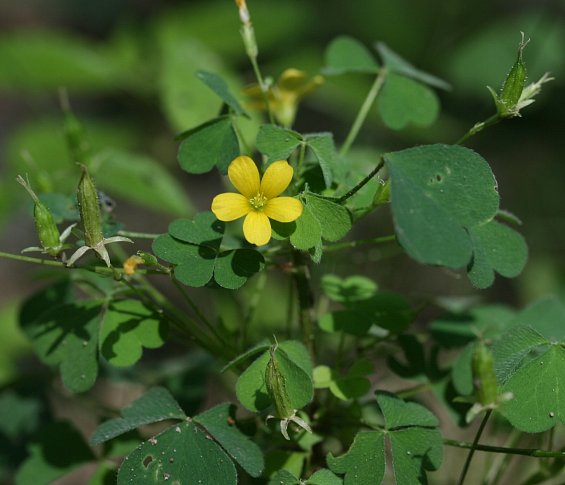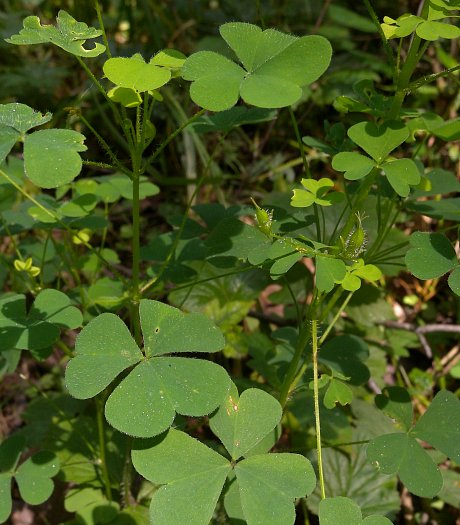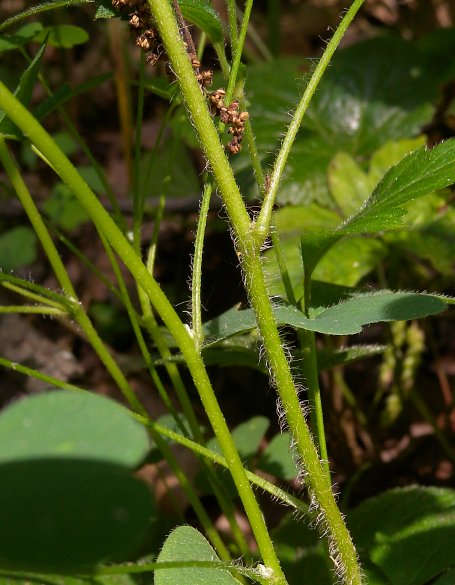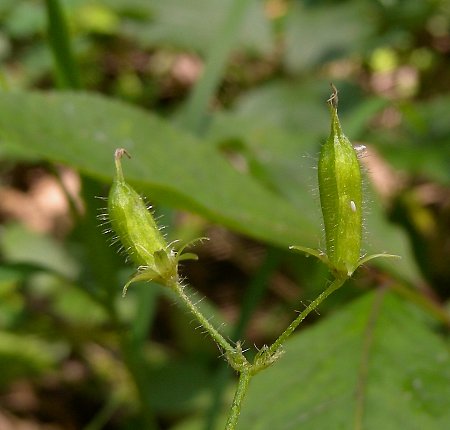
Small umbels or cymes of 2-8 flowers are produced from the axils of leaves. These flowers are about ¼" (6 mm.) or a little more across when they are fully open. Each flower consists of 5 yellow petals, 5 light green sepals, 10 stamens, and a pistil. The 5 styles of the pistil are joined together, except at their apices. The petals are oblanceolate in shape with either broadly rounded or slightly notched tips. The sepals are linear-lanceolate in shape, glabrous or slightly hairy, and about 3-4 mm. in length; they are shorter than the petals. The pedicels are light green and either glabrous or they are covered with spreading hairs; they are erect or ascending and up to 1" (2.5 cm.) long. At the base each umbel or cyme, there is a pair of tiny linear-lanceolate bractlets. The blooming period can occur from late spring to the mid-autumn; a small colony of plants may remain in bloom for 2-4 months. Only a small number of flowers are in bloom at the same time; they are diurnal. Afterwards, the flowers are replaced by seed capsules about 5-13 mm. long that are cylindrical in shape and 5-sided; their apices are beak-shaped. Immature capsules are light green and either glabrous or covered with spreading hairs along the ridges of its sides. Eventually, these capsules split open into 5 parts to eject their seeds up to several feet away from the mother plants. The small seeds are about 1.0-1.5 mm. long, brown, broadly ellipsoid in shape, and somewhat flattened; they have several transverse ridges that are non-whitened. The root system consists of a taproot that branches.

Cultivation: The preference is light shade to full sun, moist to dry-mesic conditions, and a fertile loamy soil, although other kinds of soil are tolerated. This plant can spread aggressively by reseeding itself.
Range & Habitat: Yellow Wood Sorrel (Oxalis fontana) is common, occurring in every county of Illinois, where it is native (see Distribution Map). It is widely distributed in central and eastern United States, including adjacent areas of southern Canada. Habitats include deciduous woodlands, savannas, glades, bluffs, woodland borders, grassy meadows, edges of yards, gardens, fallow fields, fence rows, vacant lots, and partially shaded waste areas. Areas with a history of disturbance are preferred.

Faunal Associations: The nectar and pollen of the flowers attract Halictid bees and other bees, flower flies (Syrphidae), bee flies (Bombyliidae), and a butterfly, the Cabbage White (Pieris rapae). Insects that feed destructively on wood sorrels (Oxalis spp.) include Abstrusomyzus reticulatus (Wood Sorrel Aphid), Rhopalosiphoninus staphyleae (Mangold Aphid), the caterpillars of a Noctuid moth, Galgula partita (The Wedgling), and various grasshoppers. Some vertebrate animals also feed on wood sorrels. The seeds of these plants are eaten by several bird species, including the Bobwhite, Painted Bunting, Slate-Colored Junco, Horned Lark, Field Sparrow, Grasshopper Sparrow, Savannah Sparrow, and Tree Sparrow. Some mice, including the Deer Mouse and White-Footed Mouse, eat the seeds. The foliage is browsed occasionally by the White-Tailed Deer and Cottontail Rabbit, even though it is mildly toxic from the presence of oxalic acid.
Photographic Location: Busey Woods in Urbana, Illinois.

Comments: The Yellow Wood Sorrel (Oxalis fontana) has dainty trifoliate leaves and small yellow flowers. Small amounts of the sour leaves can be added to salads. This wood sorrel can be difficult to distinguish from a similar species that shares the same common name, namely Oxalis stricta. The latter species differs by having short appressed hairs along its stems, petioles, and the sides of its seed capsules; its pedicels become sharply reflexed as its seed capsules become mature, instead of remaining erect or ascending. Because Oxalis stricta prefers habitats that are more sunny than Oxalis fontana, its leaves are usually more pale and it is a more densely branched and compact plant. There is disagreement regarding the taxonomy of these two species of wood sorrel. The treatment here follows Mohlenbrock (2002) and Yatskievych (1999). Other authorities refer to Oxalis fontana as Oxalis stricta, and they refer Oxalis stricta as Oxalis dillenii (Mohlenbrock considers Oxalis dillenii to be a junior synonym of Oxalis stricta). This has been a source of confusion regarding the identity of these two species. Another yellow-flowered species, Oxalis corniculata (Creeping Wood Sorrel), can be distinguished from the preceding two species by its creeping stolons, leaflets that are often reddish, and leaflet margins that are conspicuously ciliate.